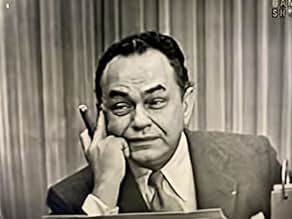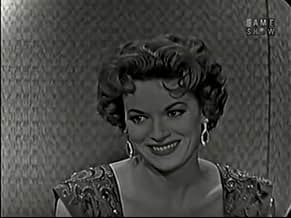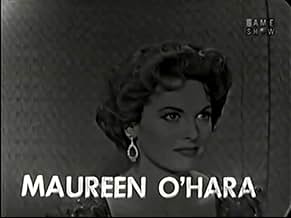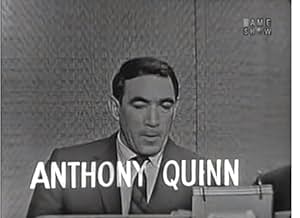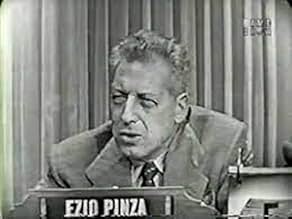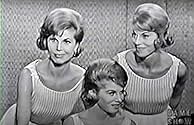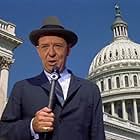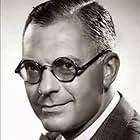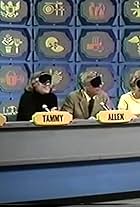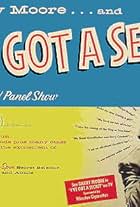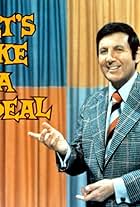What's My Line?
- TV Series
- 1950–1967
- 30m
IMDb RATING
8.5/10
1.8K
YOUR RATING
Four panelists must determine guests' occupations - and, in the case of famous guests, while blindfolded, their identity - by asking only "yes" or "no" questions.Four panelists must determine guests' occupations - and, in the case of famous guests, while blindfolded, their identity - by asking only "yes" or "no" questions.Four panelists must determine guests' occupations - and, in the case of famous guests, while blindfolded, their identity - by asking only "yes" or "no" questions.
- Won 3 Primetime Emmys
- 5 wins & 2 nominations total
Browse episodes
Featured reviews
The best "What My Lines" to me are the ones from the 1950's I tape 7 days a week from the Game Show Network.
There is so much history. I have seen many notable people/celebrities from the 50's--Conrad Hilton (Hilton Hotels), Rodgers & Hammerstein, Jo Stafford, Walt Disney, Jane Powell, Lucy & Desi, just to name a few.
Also, as stated here, there's a class and sophistication that is evident from the very beginning of the shows.
Arlene and Dorothy would be introduced and would gracefully appear in the most glamourous/classy dresses and evening gowns.
I loved Bennett Ceif. He was so intelligent and funny. He was publisher and was well versed on so many subjects.
I am taping every one I can because I know in another 10 to 20 years these may never be available again. I also enjoy watching them every evening--it's just as fresh as when they first aired.
There is so much history. I have seen many notable people/celebrities from the 50's--Conrad Hilton (Hilton Hotels), Rodgers & Hammerstein, Jo Stafford, Walt Disney, Jane Powell, Lucy & Desi, just to name a few.
Also, as stated here, there's a class and sophistication that is evident from the very beginning of the shows.
Arlene and Dorothy would be introduced and would gracefully appear in the most glamourous/classy dresses and evening gowns.
I loved Bennett Ceif. He was so intelligent and funny. He was publisher and was well versed on so many subjects.
I am taping every one I can because I know in another 10 to 20 years these may never be available again. I also enjoy watching them every evening--it's just as fresh as when they first aired.
"What's My Line?" is hailed as the longest running PRIME TIME quiz show in TV history. And for very good reason. It was, and is, unparalleled in style, wit, and sophistication. I recently saw this series again on "Game Show Network" and madly taped many of these classic episodes that instantly brought back fond memories of a time when something as minor as a silly little game show aimed for class.
In Buffalo, where I was raised, the show came on at 10:30 p.m. on Sunday nights, right after "Candid Camera." That was pretty late for an elementary kid on a school night. If I was lucky, I could cajole my mother into letting me see "Camera," but "What's My Line?" was out of the question. Invariably, the sneak that I was, I'd carefully creep down and sit on the stairs out of harm's way (meaning my mother) and catch my favorite show.
Three of the four panelists of "What's My Line?" were regulars. They were joined by one "special guest" each week (after regular Fred Allen died in 1956). Many of the guests were painfully out of their element here and couldn't hold a candle to the pros. But sometimes a big "film star" like John Payne, Jane Powell, or even Frank Sinatra would grace the panel, making for a special evening. Normally, however, it was a well-known entertainer or personality (Johnny Carson, Joey Bishop, Tony Randall, Gore Vidal, Zsa Zsa Gabor) who was there to promote a book or upcoming appearance.
For some reason, one of my favorite parts was the introduction of the panelists and moderator ("Let's meet our What's My Line" panel!"). The ladies with their sweeping gowns and gents with their penguin tuxedos just seemed to make gloriously stylish entrances that always seemed to get the evening off to a grand start.
The parlor game was quite simple. The four panelists had to guess the occupation (normally unusual -- i.e., cow dentist) of a contestant by asking yes-or-no questions. The only hint given was if the contestant was salaried and dealt in a service or with a product. A total of ten "no" answers and the game was over. The contestant would win a HUGE pot of $50.00. Such questions asked were: "Does your work take you outdoors?" or "Is your product a liquid as opposed to a solid?" Steve Allen, a one-time regular, is credited with introducing into the American vernacular, "Is it bigger than a bread box?" Each evening after two or three occupations were played out, the panel would be blindfolded and a "mystery guest" (usually in the entertainment field, but not always) would try to be identified using the same yes-or-no questioning. The mystery guests were no slouches either. Major stars (Barbra Streisand, Joe DiMaggio, The Supremes, Dustin Hoffman) would appear for added thrills. Sometimes I would cover my own eyes to see if I could guess who it was.
The elite panel of New York-based personalities were a major contributing factor to the success of "What's My Line." Dorothy Kilgallen, the razor-tongued syndicated columnist of "The Voice of Broadway," was on the panel from its inception and was easily the show's most fervent game player -- prone to anxiety, I understand, when she was on a losing streak. I remember her at times even challenging the moderator and being slightly perturbed if she "unfairly" got a "no" answer. But Dorothy always gave it her all and those of us who were major game enthusiasts related to the competitive spirit in her. Arlene Francis was a stylish actress of stage, screen and TV and easily provided the show with its warmth and witty one-liners, not to mention slightly off-color double-entendres. Her formal gowns were quite extreme for a game show but always an attention-getter. Droll Bennett Cerf was the stocky, avuncular publisher from Random House whose relaxed, ingratiating style was a special treat -- known best for inundating the audience and panelists with groan-producing jokes.
The glue, however, that held it all together was the erudite moderator John Charles Daly, a respected journalist and newscaster on his own and remarkably eloquent when put on the spot. Marvelously witty and a master of the English language, he was quite astounding (and artfully verbose) at times when having to give an explanation to a "yes" or "no" answer. Daly, along with "To Tell the Truth" host Bud Collyer, were the last of a quickly dying breed -- they were amiable but cultivated gentleman who knew how to have sophisticated fun. Gentlemen you wanted to emulate. They succeeded in giving a simple little parlor game show some poise and dignity. "The Price Is Right" host Bob Barker certainly possesses a classy style but the contestants and game show set-up lends itself to total trailer park mentality.
"What's My Line?" suffered an insurmountable loss when Dorothy Kilgallen died suddenly and mysteriously from an overdose of barbiturates in 1965 (probably a suicide). She was terribly missed, considering she was part of the "family" from the very first telecast. The show finally went off the air in 1967, and though it quickly returned in syndication with panelist Arlene Francis, it had lost all its charm and elegance. With regular team members like Soupy Sales, what could one expect?
If I could turn back the hands of time, I'm sure I would set it for 10:30 p.m. on Sunday evening. That was a magic half-hour for me, whether my mother knew it or not. It was worth being dead tired on Monday morning.
In Buffalo, where I was raised, the show came on at 10:30 p.m. on Sunday nights, right after "Candid Camera." That was pretty late for an elementary kid on a school night. If I was lucky, I could cajole my mother into letting me see "Camera," but "What's My Line?" was out of the question. Invariably, the sneak that I was, I'd carefully creep down and sit on the stairs out of harm's way (meaning my mother) and catch my favorite show.
Three of the four panelists of "What's My Line?" were regulars. They were joined by one "special guest" each week (after regular Fred Allen died in 1956). Many of the guests were painfully out of their element here and couldn't hold a candle to the pros. But sometimes a big "film star" like John Payne, Jane Powell, or even Frank Sinatra would grace the panel, making for a special evening. Normally, however, it was a well-known entertainer or personality (Johnny Carson, Joey Bishop, Tony Randall, Gore Vidal, Zsa Zsa Gabor) who was there to promote a book or upcoming appearance.
For some reason, one of my favorite parts was the introduction of the panelists and moderator ("Let's meet our What's My Line" panel!"). The ladies with their sweeping gowns and gents with their penguin tuxedos just seemed to make gloriously stylish entrances that always seemed to get the evening off to a grand start.
The parlor game was quite simple. The four panelists had to guess the occupation (normally unusual -- i.e., cow dentist) of a contestant by asking yes-or-no questions. The only hint given was if the contestant was salaried and dealt in a service or with a product. A total of ten "no" answers and the game was over. The contestant would win a HUGE pot of $50.00. Such questions asked were: "Does your work take you outdoors?" or "Is your product a liquid as opposed to a solid?" Steve Allen, a one-time regular, is credited with introducing into the American vernacular, "Is it bigger than a bread box?" Each evening after two or three occupations were played out, the panel would be blindfolded and a "mystery guest" (usually in the entertainment field, but not always) would try to be identified using the same yes-or-no questioning. The mystery guests were no slouches either. Major stars (Barbra Streisand, Joe DiMaggio, The Supremes, Dustin Hoffman) would appear for added thrills. Sometimes I would cover my own eyes to see if I could guess who it was.
The elite panel of New York-based personalities were a major contributing factor to the success of "What's My Line." Dorothy Kilgallen, the razor-tongued syndicated columnist of "The Voice of Broadway," was on the panel from its inception and was easily the show's most fervent game player -- prone to anxiety, I understand, when she was on a losing streak. I remember her at times even challenging the moderator and being slightly perturbed if she "unfairly" got a "no" answer. But Dorothy always gave it her all and those of us who were major game enthusiasts related to the competitive spirit in her. Arlene Francis was a stylish actress of stage, screen and TV and easily provided the show with its warmth and witty one-liners, not to mention slightly off-color double-entendres. Her formal gowns were quite extreme for a game show but always an attention-getter. Droll Bennett Cerf was the stocky, avuncular publisher from Random House whose relaxed, ingratiating style was a special treat -- known best for inundating the audience and panelists with groan-producing jokes.
The glue, however, that held it all together was the erudite moderator John Charles Daly, a respected journalist and newscaster on his own and remarkably eloquent when put on the spot. Marvelously witty and a master of the English language, he was quite astounding (and artfully verbose) at times when having to give an explanation to a "yes" or "no" answer. Daly, along with "To Tell the Truth" host Bud Collyer, were the last of a quickly dying breed -- they were amiable but cultivated gentleman who knew how to have sophisticated fun. Gentlemen you wanted to emulate. They succeeded in giving a simple little parlor game show some poise and dignity. "The Price Is Right" host Bob Barker certainly possesses a classy style but the contestants and game show set-up lends itself to total trailer park mentality.
"What's My Line?" suffered an insurmountable loss when Dorothy Kilgallen died suddenly and mysteriously from an overdose of barbiturates in 1965 (probably a suicide). She was terribly missed, considering she was part of the "family" from the very first telecast. The show finally went off the air in 1967, and though it quickly returned in syndication with panelist Arlene Francis, it had lost all its charm and elegance. With regular team members like Soupy Sales, what could one expect?
If I could turn back the hands of time, I'm sure I would set it for 10:30 p.m. on Sunday evening. That was a magic half-hour for me, whether my mother knew it or not. It was worth being dead tired on Monday morning.
Suffering an obsession with the JFK Assassination, I discovered a Ms. Dorothy Kilgallon entangled in the mess. After researching this incredible woman, I started watching 'What's My Line'; having always disagreed with gameshows, I maintained a wearying distance for, ahhhhh 5 seconds :D Within the first few moments I was hooked; the original panelists and Jon Daly exhibit erudition, reason, and humour. Fully exemplary of the class, intelligence, communication, and confidence that America has lacked for entirely too long, I feel as if 'What's My Line?' should be required watching in school, lol! So! My third episode is tonight. I CAN'T WAIT!
I watched "What's My Line" as a child and am grateful for the chance to see the series again as part of the Game Show Network's current lineup (as of January 2003). This particular show is wonderful in all it's incarnations, though I really enjoy the "early years" from 1951 thru 1967. Besides the fun of guessing the contestants' occupations, it's a joy to listen to the humorous banter of the 4 panelists and the host John Charles Daily. The special guests add an entertaining and historical aspect to the show, as so many of the guests have long since passed away. Though I like many game shows, "What's My Line" will long remain my favorite...and one of the reasons I enjoy the late night hours lately! Check it out before the Game Show Networks revamps their lineup!
"What's My Line" is one of my favorite programs. The host, John Daly, was an excellent host. He was erudite, respectful, and professional, unlike succeeding game show hosts, who, for the most part, try to be comedians. The panel was also insightful, witty, and humorous without being crude and trying to be funny. They were truly classy people. Even more important to me is to see the civility that existed on that program compared to current programming. It certainly was a different time in terms of respect, manners, and sophistication. As an earlier reviewer, game show formats now appeal to the lowest denominator. Noteworthy is the conduct of the audience. No loud cheering, yelling, and other obnoxious behavior on " What's My line".
How I miss the golden age of television...It was certainly heads and shoulders above most of today's programs which try to pass for entertainment. As we have progressed in so many areas in the past forty years. we have certainly declined in the quality, civility, and humaneness of that earlier era.
How I miss the golden age of television...It was certainly heads and shoulders above most of today's programs which try to pass for entertainment. As we have progressed in so many areas in the past forty years. we have certainly declined in the quality, civility, and humaneness of that earlier era.
Storyline
Did you know
- TriviaDorothy Kilgallen was the mystery guest on the February 5, 1961 telecast. She had been hospitalized and missed the previous two broadcasts. Newspaper reports of the time revealed nothing about her condition, nor was it discussed on-air. In 1976 her personal chauffeur, Roosevelt Zanders, revealed that he had driven Kilgallen from New York to Washington during a blizzard so she could report on the JFK inaugural festivities for her newspaper. Immediately after the new president was sworn in (January 20, 1961), Zanders drove Kilgallen directly to a New York hospital. Asked by a biographer (in 1976) if his client's condition was alcohol-related, Zanders replied, "I don't say 'drunk.' One of the things that brought it about was having one or two drinks and not eating. Her system ran down that way." On February 5, 1961, with Bennett Cerf on vacation, Arlene Francis went on live TV assuming Kilgallen was still in the hospital only to discover that she was the mystery guest. During an earlier absence from the show in 1958, Kilgallen had reportedly suffered (according to a newspaper wire service) from "exhaustion and anemia." When she missed several shows in 1965, John Daly said on-air that she had injured herself tripping on a rug. She returned to the show with her arm in a sling and then appeared on every telecast for six months, including a live appearance on the night of her death.
- Quotes
Steve Allen: Is it bigger than a bread box?
- Crazy creditsThe uncredited announcer introduced the first panelist, sometimes the left-most, sometimes the right-most. Beginning with the first panelist, each panelist then introduced the person to his/her left or right, depending upon the first panelist's position. The fourth panelist then introduced moderator John Daly.
- ConnectionsFeatured in Television Land (1971)
- SoundtracksMelody In Moccasins
(Open Theme 1)
Composed by Wilfred Burns
Original Publisher: Charles Broude, Ltd. (ASCAP)
Original U.S. Publisher: Emil Ascher, Inc. (ASCAP)
- How many seasons does What's My Line? have?Powered by Alexa
Details
- Release date
- Country of origin
- Language
- Also known as
- Occupation Unknown
- Filming locations
- Production companies
- See more company credits at IMDbPro
- Runtime30 minutes
- Sound mix
- Aspect ratio
- 1.33 : 1
Contribute to this page
Suggest an edit or add missing content


